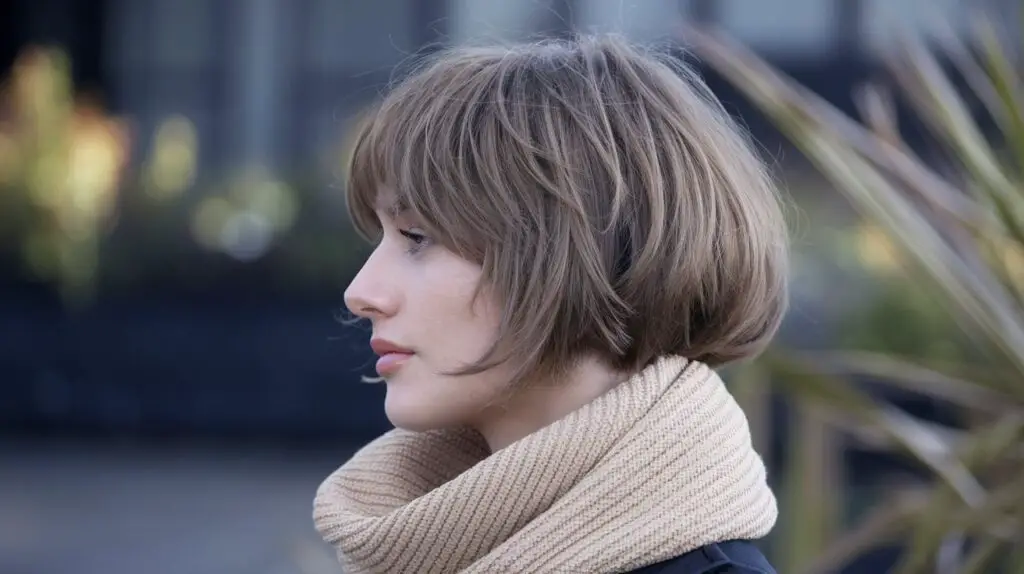The shaggy bob is a trendy haircut that combines the classic bob shape with a textured, layered finish. This versatile style offers a carefree, effortless look that many women love. While getting a professional cut is always an option, learning to trim your shaggy bob at home can save time and money.
Cutting your own hair might seem daunting at first, but with the right techniques and tools, it’s a skill you can master. A DIY haircut allows you to maintain your style between salon visits and gives you the freedom to make small adjustments whenever you want. Plus, it’s a great way to feel more confident about your hair care abilities.
We’ll cover here everything you need to know about cutting a shaggy bob at home. From understanding what makes this style unique to choosing the right tools and mastering cutting techniques, you’ll learn how to achieve and maintain this popular haircut.
- What exactly is a shaggy bob?
- Should I cut my hair wet or dry for a shaggy bob?
- What tools do I need to cut a shaggy bob at home?
- How do I section my hair for a shaggy bob cut?
- What techniques should I use to achieve the shaggy look?
- How can I style my new shaggy bob?
- Rocking Your Shaggy Bob: From Cut to Style
- Frequently Asked Questions
What exactly is a shaggy bob?

A shaggy bob is a modern twist on the classic bob haircut, combining shorter lengths with textured layers for a relaxed, effortless look. This style has gained popularity for its versatility and low-maintenance appeal. Let’s explore the key elements that define this trendy haircut.
Defining characteristics of a shaggy bob
The shaggy bob is all about texture and movement. Unlike sleek, polished bobs, this style embraces a more casual, lived-in appearance. The main features include:
- Choppy, textured layers throughout the hair
- Softer, less defined edges
- Volume at the crown
- Piece-y, tousled finish
- Face-framing layers
These elements work together to create a hairstyle that looks effortlessly cool and slightly undone.
How it differs from other bob styles
You might wonder, “What sets the shaggy bob apart from other bob haircuts?” The key difference lies in the cutting technique and overall finish. Traditional bobs often have clean lines and a more structured appearance. In contrast, the shaggy bob uses point-cutting and texturizing techniques to create a more relaxed, movable style.
Another distinction is the amount of layering. While some bob styles might incorporate minimal layering, the shaggy bob relies heavily on layers to achieve its signature textured look. This layering also helps to remove bulk and add movement to the hair.
Face shapes that suit a shaggy bob
Good news! The shaggy bob is a flattering option for many face shapes. Its versatility allows for customization to complement different facial features. Here’s a quick guide:
- Round faces: Opt for a longer shaggy bob with face-framing layers to elongate the face
- Square faces: Choose softer, more textured layers around the jawline to soften angular features
- Oval faces: This face shape can pull off most variations of the shaggy bob
- Heart-shaped faces: A shorter shaggy bob with side-swept bangs can balance out a wider forehead
Remember, these are just guidelines. The beauty of the shaggy bob is its adaptability, so don’t be afraid to experiment with different lengths and layering techniques.
Length variations of shaggy bobs
The shaggy bob isn’t a one-size-fits-all haircut. It can be customized to various lengths to suit your preferences and lifestyle. Some popular length options include:
Short shaggy bob: This chin-length style is perfect for those who want a bold, edgy look. It’s also great for adding volume to fine hair.
Medium shaggy bob: Falling between the chin and shoulders, this length offers versatility in styling and is suitable for most hair types.
Long shaggy bob (or “lob”): This shoulder-grazing style provides the texture of a shaggy bob with the added length for those who aren’t ready for a shorter cut.
Texture considerations for this style
The shaggy bob works well with various hair textures, but the styling approach may differ depending on your natural hair type. For straight hair, you might need to use texturizing products and heat styling to achieve the desired tousled look. Wavy and curly hair types often find that the shaggy bob enhances their natural texture, requiring minimal styling.
For fine hair, the layering in a shaggy bob can add volume and movement. If you have thick hair, the texturizing techniques used in this style can help remove bulk and make your hair more manageable.
Regardless of your hair texture, regular trims are essential to maintain the shape and layers of your shaggy bob. This will help preserve its effortless, lived-in appearance.
The shaggy bob offers a fresh, modern take on a classic haircut. Its adaptability to different face shapes, lengths, and hair textures makes it a popular choice for women seeking a low-maintenance yet stylish look. Whether you’re after a bold change or a subtle update to your current style, the shaggy bob might be just the haircut you’re looking for.
See also: How to Style a Shaggy Bob with Undercut
Should I cut my hair wet or dry for a shaggy bob?
Deciding whether to cut your hair wet or dry for a shaggy bob is an important consideration. Both methods have their merits, and the choice often depends on your hair type and the specific look you’re aiming for. Let’s explore the pros and cons of each approach to help you make an informed decision.
Pros of cutting wet hair
Cutting hair while it’s wet can offer several advantages, especially for certain hair types and styles. Wet hair is more manageable and lies flat, which can make it easier to achieve precise cuts. This method is particularly useful for:
- Creating clean, straight lines
- Working with thick or coarse hair
- Achieving a more uniform length
However, it’s important to note that wet hair stretches, so the final length may be shorter than anticipated once it dries.
Advantages of cutting dry hair
On the flip side, cutting dry hair allows you to see exactly how the style will look in its natural state. This can be particularly beneficial for a shaggy bob, which relies heavily on texture and movement. Some advantages of dry cutting include:
- Better visibility of the hair’s natural texture and movement
- Easier to create and see layers and texture
- More accurate length assessment
- Ability to work with the hair’s natural fall and cowlicks
For these reasons, many stylists prefer dry cutting for styles like the shaggy bob.
How hair texture affects the decision
Your hair’s texture plays a significant role in determining whether to cut it wet or dry. Fine, straight hair may benefit from a wet cut to achieve precision. In contrast, curly or wavy hair often responds better to dry cutting, as it allows the stylist to see how each curl or wave will behave.
Question: What if you have mixed textures in your hair?
Answer: If you have mixed textures, a combination approach might work best. Your stylist might cut the bulk of your hair wet for precision, then fine-tune and add texture once it’s dry.
Tips for dampening hair if needed
If you decide to start with dry hair but find you need some moisture for control, here are some tips for lightly dampening your hair:
- Use a spray bottle filled with water
- Apply a leave-in conditioner for added control
- Focus on dampening the sections you’re actively cutting
- Avoid over-wetting the hair, as this can lead to inaccurate length assessment
Remember, the goal is to add just enough moisture to make the hair manageable without losing the benefits of dry cutting.
Importance of hair’s natural fall
Understanding your hair’s natural fall is crucial when creating a shaggy bob. This style is all about enhancing your hair’s natural texture and movement. Cutting your hair dry allows you to see:
- How your hair naturally parts
- Where cowlicks or stubborn areas might cause issues
- How layers will sit once styled
- The overall shape and volume of your hair
By considering these factors, you can create a shaggy bob that works with your hair’s natural tendencies rather than against them.
Ultimately, the decision to cut your hair wet or dry for a shaggy bob depends on your hair type, desired outcome, and personal preference. Many stylists recommend a combination approach: cutting the initial shape and length while the hair is damp, then fine-tuning and adding texture once it’s dry. This method allows for both precision and an accurate assessment of how the style will look in real life.
If you’re cutting your hair at home, starting with dry hair might be safer, as it reduces the risk of cutting too much due to wet hair’s tendency to stretch. Whichever method you choose, take your time and cut conservatively. You can always trim more, but you can’t undo a cut that’s too short.
What tools do I need to cut a shaggy bob at home?
Cutting your own hair can be a rewarding experience, especially when you have the right tools at your disposal. For a shaggy bob, you’ll need a few key items to achieve that perfectly tousled look. Let’s explore the essential tools you’ll want to have on hand before you start snipping.
Best scissors for home haircuts
The foundation of any good haircut is a quality pair of scissors. But what makes a pair of scissors suitable for cutting hair? Look for shears specifically designed for hair cutting. These typically have sharper blades and a more comfortable grip compared to regular household scissors.
Here are some features to consider:
- Blade length: 5.5 to 6.5 inches is ideal for most home haircuts
- Material: Stainless steel or Japanese steel for durability
- Tension: Adjustable tension for precision cutting
- Ergonomics: Comfortable grip to prevent hand fatigue
Investing in a good pair of hair-cutting scissors will make your DIY haircut much easier and more precise.
Importance of hair clips and sectioning tools
Now, you might be wondering, “Why do I need clips? Can’t I just hold my hair with my hands?” While it’s possible to cut your hair without clips, using them will significantly improve your results. Hair clips and sectioning tools help you:
- Separate your hair into manageable sections
- Keep cut and uncut hair separate
- Maintain tension for more accurate cutting
- Free up both hands for cutting
For a shaggy bob, you’ll want to use clips to section your hair horizontally and vertically. This allows you to work on one layer at a time, creating that signature textured look.
Using a spray bottle effectively
A spray bottle filled with water is a simple yet crucial tool for at-home haircuts. It allows you to dampen your hair as needed, which can make it easier to cut evenly. For a shaggy bob, you might prefer to cut your hair when it’s slightly damp rather than soaking wet.
To use your spray bottle effectively:
- Fill it with room temperature water
- Adjust the nozzle to a fine mist setting
- Spray your hair evenly, focusing on the sections you’re about to cut
- Avoid over-wetting your hair, as this can lead to inaccurate length assessment
Choosing the right comb for your hair type
The type of comb you use can make a big difference in your haircut results. For a shaggy bob, you’ll want a comb that can help you create texture and layers. A wide-tooth comb or a cutting comb with both wide and fine teeth can be ideal.
If you have curly or textured hair, opt for a wide-tooth comb to prevent frizz and maintain your natural curl pattern. For straight or fine hair, a fine-tooth comb can help you achieve more precise cuts.
Mirror setup for optimal visibility
Proper visibility is crucial when cutting your own hair. A single mirror in front of you isn’t enough – you’ll need to see the back and sides of your head too. Here’s a setup that can help:
- Position a large mirror in front of you
- Place a smaller hand-held mirror behind you
- Adjust the angles so you can see the back of your head in the reflection of the hand-held mirror in your main mirror
This setup allows you to check your progress from all angles as you cut. It might take some practice to get used to working with mirror reflections, but it’s an essential skill for DIY haircuts.
By gathering these tools before you start, you’ll be well-prepared to create your shaggy bob at home. Remember, the key to a successful DIY haircut is patience and the right equipment. Take your time, work in small sections, and don’t be afraid to step back and reassess your progress as you go.
With practice and the proper tools, you’ll be able to maintain your shaggy bob between salon visits or even create a whole new look from the comfort of your own home. Happy cutting!
See also: How to Style a Short Shaggy Bob
How do I section my hair for a shaggy bob cut?
Proper sectioning is a crucial step in creating a shaggy bob at home. It helps you maintain control and achieve an even cut throughout your hair. Let’s explore the process of sectioning your hair for this stylish cut.
Creating a center part
Start by creating a clean center part. This serves as your guide for the entire haircut. To find your natural part, use the tip of a comb and run it from your forehead to the back of your head. The point where your hair naturally separates is your center part. If you prefer an off-center or side part, that’s fine too – just make sure it’s straight and consistent.
Why is this important? A well-defined part helps you maintain symmetry as you cut. It also allows you to compare the length and shape of both sides of your hair easily.
Dividing hair into manageable sections
Once you’ve established your part, it’s time to divide your hair into sections. For a shaggy bob, you’ll typically want to create four main sections:
- Two front sections (left and right)
- Two back sections (upper and lower)
To create these sections, imagine drawing a line from ear to ear over the top of your head. This separates the front from the back. Then, divide the back into upper and lower sections by drawing a horizontal line at about ear level.
Securing sections with clips
Now that you’ve divided your hair, you need to keep those sections separate. This is where hair clips come in handy. Use sturdy clips to secure each section. Make sure the clips are strong enough to hold your hair in place but gentle enough not to leave marks or cause breakage.
A question you might have is, “How tightly should I clip my hair?” The answer: Secure enough to keep hair in place, but not so tight that it causes discomfort or distorts your hair’s natural fall.
Importance of even sectioning
Even sectioning is key to achieving a balanced, professional-looking cut. Uneven sections can lead to inconsistent lengths and an overall unbalanced appearance. Take your time with this step – it’s better to spend a few extra minutes getting your sections right than to rush and end up with an uneven cut.
Here are some tips for even sectioning:
- Use a mirror to check the back of your head
- Make sure your partings are straight
- Keep sections the same size on both sides of your head
- Double-check your work before you start cutting
Adjusting sections for different hair types
Different hair types may require slight adjustments to the sectioning process. For example, if you have very thick hair, you might need to create smaller, more numerous sections to maintain control. On the other hand, if you have fine hair, larger sections might work better.
Curly hair often benefits from being sectioned while dry, as curls can shrink and change shape when wet. If you have wavy hair, consider sectioning it in its natural state to work with, rather than against, your hair’s natural texture.
For those with longer hair transitioning to a bob, you might find it helpful to create an additional horizontal section at the nape of your neck. This can make it easier to establish the initial length of your bob.
Remember, sectioning is not just about dividing your hair – it’s about creating a roadmap for your cut. Well-sectioned hair makes the cutting process smoother and more precise, helping you achieve that perfect shaggy bob look.
As you section your hair, take a moment to familiarize yourself with how your hair falls naturally. This will help you work with your hair’s natural tendencies as you cut, resulting in a more flattering and easier-to-style shaggy bob.
With your hair properly sectioned, you’re now ready to move on to the actual cutting process. Take a deep breath, keep your sections neat, and get ready to transform your look!
What techniques should I use to achieve the shaggy look?

Creating a shaggy bob requires specific cutting techniques to achieve that effortlessly textured look. Let’s explore the methods you can use to give your hair that coveted shaggy style.
Point-cutting method for texture
Point-cutting is a fundamental technique for creating texture in a shaggy bob. Instead of cutting straight across, you’ll hold the scissors vertically and snip into the ends of your hair. This creates soft, uneven edges that give your hair movement and a lived-in appearance.
To point-cut effectively:
- Take a small section of hair between your fingers
- Hold the scissors vertically, points facing up
- Make small, quick snips into the ends
- Vary the depth of your cuts for a natural look
Remember, less is more when point-cutting. Start with shallow cuts and gradually increase depth as you become more comfortable with the technique.
Creating layers with vertical cuts
Vertical cuts are key to achieving the layered look of a shaggy bob. Unlike horizontal cuts that create a blunt edge, vertical cuts allow for a more natural blend and softer layers.
How do you make vertical cuts? Follow these steps:
- Section your hair as previously discussed
- Take a small section and hold it straight out from your head
- Position your scissors vertically along the length of the hair
- Cut upwards in a straight line, moving the scissors slightly as you go
- Repeat this process throughout your hair, varying the length of your cuts
Techniques for adding volume
Volume is a hallmark of the shaggy bob. To add lift and body to your cut, try these techniques:
- Cut shorter layers at the crown: This creates lift at the roots
- Use thinning shears sparingly: Remove bulk without losing length
- Cut at an angle: Slightly elevate sections as you cut for built-in volume
Question: “How do I know if I’m cutting too much?” Answer: Start conservatively. You can always cut more, but you can’t put hair back once it’s cut.
How to cut face-framing pieces
Face-framing layers can enhance your features and add softness to your shaggy bob. Here’s how to cut them:
- Part your hair as desired
- Take a small section from each side of your part
- Comb this hair forward and hold it between your fingers
- Cut at a slight angle, longer near your chin and shorter as you move up
- Point-cut into these pieces for a softer edge
Adjust the length and angle of these pieces based on your face shape and personal preference.
Blending tips for a seamless look
Blending is crucial for a natural-looking shaggy bob. Without proper blending, your layers might appear choppy or disconnected. Try these blending techniques:
- Cross-check your cuts: Look at your hair from different angles
- Use your fingers to lift and check how layers fall together
- Soften any harsh lines with point-cutting
- Twist small sections and snip into them for a textured blend
The key to successful blending is patience and attention to detail. Take your time and make small adjustments as needed.
As you work through these techniques, remember that the shaggy bob is meant to look effortless and slightly undone. Don’t aim for perfection – a little asymmetry and unevenness can add to the overall effect.
Practice these techniques on small sections before committing to a full cut. You might even consider practicing on a wig or hair extensions first to build your confidence.
By mastering these cutting techniques, you’ll be well on your way to creating a stylish shaggy bob at home. The more you practice, the more natural and effortless your cuts will become. Happy styling!
See also: What is a Layered Shaggy Bob Haircut and How to Style One
How can I style my new shaggy bob?

Your new shaggy bob offers a world of styling possibilities. This versatile cut can be worn in various ways, from effortlessly tousled to sleek and polished. Let’s explore some techniques to make the most of your fresh look.
Products that enhance the shaggy texture
The key to a great shaggy bob lies in its texture. To amplify your hair’s natural movement, consider using texturizing products. A sea salt spray can work wonders, adding grit and separation to your strands. For finer hair types, a volumizing mousse applied at the roots can create lift and body.
Curious about which product to choose? Think about your hair type and desired outcome. If you want a piece-y, lived-in look, opt for a dry texturizing spray. For a softer, more natural finish, a lightweight styling cream might be your best bet.
Heat styling techniques for different looks
While the shaggy bob shines in its natural state, heat styling can create a variety of looks. For a sleek appearance, use a flat iron to smooth your layers, focusing on the ends to maintain some texture. Want more volume? Try this trick:
- Section your hair
- Use a round brush and blow dryer
- Direct the airflow upwards at the roots
- Finish with a cool shot to set the style
For beachy waves, wrap small sections around a curling wand, alternating directions for a more natural effect. Remember to use a heat protectant before any hot tool styling to keep your hair healthy.
Air-drying methods for natural texture
One of the beauties of a shaggy bob is its ability to air-dry beautifully. To enhance your natural texture, start by applying a leave-in conditioner to damp hair. Scrunch your hair gently to encourage wave formation. For added definition, try twisting small sections away from your face and letting them dry naturally.
A question you might have is, “How can I avoid frizz when air-drying?” The answer lies in your technique. Avoid touching your hair too much as it dries, and consider using a microfiber towel or old t-shirt to remove excess water instead of a regular towel, which can cause friction and frizz.
Maintaining the cut between trims
To keep your shaggy bob looking its best, regular maintenance is key. Use a clarifying shampoo once a week to remove product buildup that can weigh down your layers. Deep condition your hair to keep it soft and manageable.
Trimming your own hair between salon visits can be tricky, but not impossible. If you notice split ends, carefully snip them with sharp hair scissors. Focus on the ends and avoid cutting into the layers, which could alter the shape of your cut.
Quick styling tricks for busy mornings
On those hectic mornings when time is of the essence, these quick styling tricks can save the day:
- Dry shampoo refresh: Sprinkle dry shampoo at the roots, massage in, and brush out for instant volume and freshness.
- Messy bun: Gather your hair at the nape of your neck, twist, and secure with pins for an effortless updo.
- Headband tuck: Use a wide headband to sweep your hair back, tucking the ends under for a chic look in seconds.
For a quick texture boost, try this: Flip your head upside down, spray with texturizing spray, and scrunch. Flip back up and you’re good to go!
Your shaggy bob is a versatile canvas for creativity. Experiment with different products and techniques to find what works best for your hair type and lifestyle. With a little practice, you’ll master the art of styling your new cut in no time.
Below some popular shaggy bob style variations:
| Style Variation | Description | Best For |
|---|---|---|
| Classic Shaggy Bob | Textured layers with a slightly messy finish | All hair types and face shapes |
| Asymmetrical Shaggy Bob | One side longer than the other, with textured layers | Adding edge to your look, suits oval and heart-shaped faces |
| Curly Shaggy Bob | Embraces natural curls with layered, bouncy texture | Curly hair types, adds volume |
| Choppy Shaggy Bob | More defined, piece-y layers for a rockstar vibe | Thick hair, adds movement and reduces bulk |
| Long Shaggy Bob (“Lob”) | Shoulder-length with shaggy layers | Those wanting to keep some length, suits most face shapes |
| Shaggy Bob with Bangs | Incorporates textured fringe with the classic shaggy bob | Adding softness around the face, suits high foreheads |
| Platinum Shaggy Bob | Bleached blonde color with shaggy texture | Making a bold statement, suits cool skin tones |
| Layered Shaggy Bob | Heavy layering throughout for maximum texture and movement | Fine hair, adds volume and dimension |
Rocking Your Shaggy Bob: From Cut to Style

The shaggy bob is more than just a haircut – it’s a versatile style that can be customized to suit your unique personality and lifestyle. By mastering the techniques of sectioning, cutting, and styling, you’ve gained the skills to maintain and refresh your look at home. Remember that practice makes perfect, so don’t be discouraged if your first attempts aren’t salon-perfect. With time and patience, you’ll develop a keen eye for shaping and styling your shaggy bob.
Your new haircut offers endless possibilities for expression. Whether you prefer a tousled, beachy look or a sleek, polished style, your shaggy bob can adapt to any occasion. Experiment with different products, styling methods, and accessories to discover the variations that make you feel most confident. As you become more comfortable with your shaggy bob, you’ll find that it’s not just a hairstyle, but a reflection of your personal flair and creativity.
Frequently Asked Questions
Q: What is a shaggy bob?
A: A shaggy bob is a short to medium-length haircut with textured layers and a slightly undone, effortless look.
Q: Should I cut my hair wet or dry for a shaggy bob?
A: It’s generally better to cut hair dry for a shaggy bob, as it allows you to see how the hair naturally falls and creates texture.
Q: What tools do I need to cut a shaggy bob at home?
A: You’ll need sharp hair-cutting scissors, hair clips for sectioning, a spray bottle, a comb, and mirrors for viewing all angles of your head.
Q: How do I section my hair for cutting a shaggy bob?
A: Create a center part, then divide your hair into four main sections: two in front and two in back, securing each with clips.
Q: What’s the point-cutting method?
A: Point-cutting involves holding the scissors vertically and snipping into the ends of the hair to create texture and soften edges.
Q: How can I add volume to my shaggy bob?
A: Add volume by cutting shorter layers at the crown, using thinning shears sparingly, and cutting at a slight angle.
Q: What products work best for styling a shaggy bob?
A: Texturizing sprays, sea salt sprays, and lightweight styling creams can enhance the shaggy texture of your bob.
Q: Can I air-dry my shaggy bob?
A: Yes, air-drying works well for a shaggy bob. Apply leave-in conditioner to damp hair, scrunch gently, and avoid touching your hair as it dries to prevent frizz.
Q: How often should I trim my shaggy bob?
A: Regular trims every 6-8 weeks can help maintain the shape of your shaggy bob, but you can also do light maintenance trims at home between salon visits.

